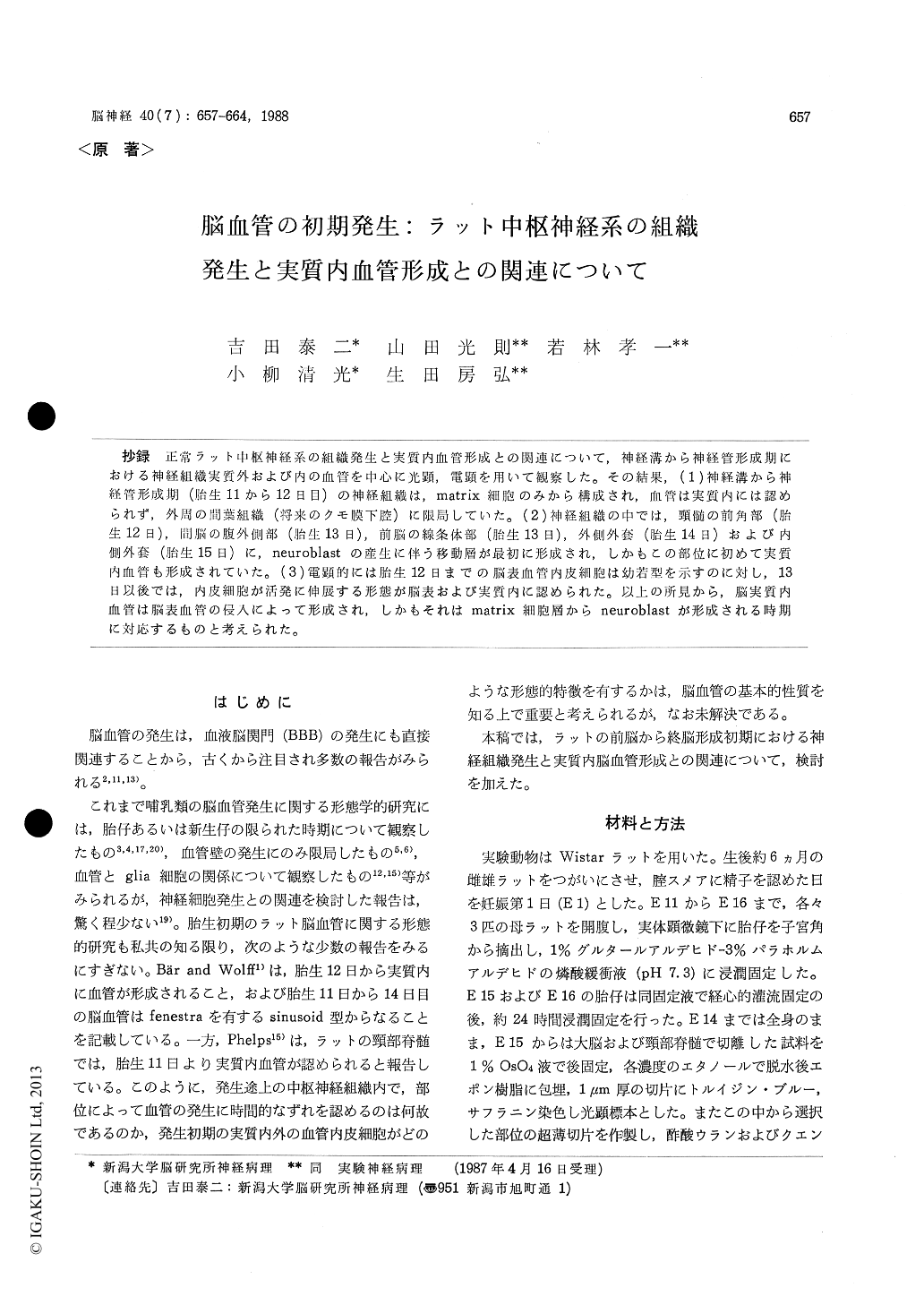Japanese
English
- 有料閲覧
- Abstract 文献概要
- 1ページ目 Look Inside
抄録 正常ラット中枢神経系の組織発生と実質内血管形成との関連について,神経溝から神経管形成期における神経組織実質外および内の血管を中心に光顕,電顕を用いて観察した。その結果,(1)神経溝から神経管形成期(胎生11から12日目)の神経組織は,matrix細胞のみから構成され,血管は実質内には認められず,外周の間葉組織(将来のクモ膜下腔)に限局していた。(2)神経組織の中では,頸髄の前角部(胎生12日),間脳の腹外側部(胎生13日),前脳の線条体部(胎生13日),外側外套(胎生14日)および内側外套(胎生15日)に,neuroblastの産生に伴う移動層が最初に形成され,しかもこの部位に初めて実質内血管も形成されていた。(3)電顕的には胎生12日までの脳表血管内皮細胞は幼若型を示すのに対し,13日以後では,内皮細胞が活発に伸展する形態が脳表および実質内に認められた。以上の所見から,脳実質内血管は脳表血管の侵入によって形成され,しかもそれはmatrix細胞層からneuroblastが形成される時期に対応するものと考えられた。
The purpose of this study is to evaluate the mor-phological relevance to cerebral histogenesis and internal vascularization during early fetal develop-ment of rats. Using light and electron microsco-pes, fetal brains and spinal cords from embryonic day 11 (E 11) to E 16 were observed with special attention to new blood vessel formation in the parenchyma. At stages of the neural groove and neural tube blood vessels were confined in the perineural mesenchyma around the matrix cell layer whose cytoarchitecture was arranged in a pseudostratified pattern and did not include the blood vessels. At the prosencephalic stage (E 13), primordium of the striatum which localized in the ventrolateral portion of the cerebral neopallium made up the migrating zone in outer most of thematrix cell layer and blood vessels firstly appeared in this area. Similarly, the blood vessels were also recognized at the ventro-lateral portion of the mesencephalon where the migrating zone was ini-tially formed on E 13. In the cervical spinal cord, the blood vessels were initially recognized on E 12, when the migrating zone was formed at the area of anterior horn. At the early telencephalic stage dur-ing E 14-E 15, blood vessels were evenly distribu-ted in the lateral cerebral neopallium, while the cerebral neopallium in the midline where took place later evolution than lateral neopallium was still remaining in the state of matrix cell layer only, and was also lacking the blood vessels. In this area, first appearance of the vessels was E 15 or E 16.
Ultrastructually, newly formed endothelial cells in the perineural mesenchyma before the embryo-nic day 12 had abundant cytoplasm with small vascular lumen in their cytoplasm. Some endothe-lial cells also made up a vascular lumen by connec-tion with neighbour endothelial cells at the cyto-plasmic periphery. On the other hand, after the embryonic day 13, they have more elongated cyto-plasm accompanied with many large vesicle for-mation at the luminal side and irregular filopodia at the abluminal side. Based on these results it was suggested that the first internal vascularization which formed by elongation and invasion of the perineural blood vessels was closely related with the appearance of the migrating zone in the neo-pallium, and participated in the neuroblast forma-tion in the brain.

Copyright © 1988, Igaku-Shoin Ltd. All rights reserved.


